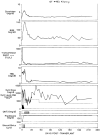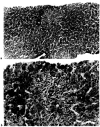Use of OKT3 with cyclosporin and steroids for reversal of acute kidney and liver allograft rejection
- PMID: 3306422
- PMCID: PMC2994552
- DOI: 10.1159/000184431
Use of OKT3 with cyclosporin and steroids for reversal of acute kidney and liver allograft rejection
Abstract
OKT3 monoclonal antibody therapy was added to preexisting baseline immunosuppressive treatment with ciclosporin and steroids to treat rejection in 52 recipients of cadaveric livers and 10 recipients of cadaveric kidneys. Rejection was controlled in 75% of patients treated, often after high-dose steroid therapy had failed. Rejection recurred during the 17-month follow-up period, after completion of OKT3, in only 25% of the patients who had responded. The safety and effectiveness of this monoclonal therapy, added to ciclosporin and steroids, has been established in this study.
Figures











References
-
- Griepp R, Stinson E, Dong E, et al. The use of antithymocyte globulin in human heart transplantation. Circulation. 1972;45(suppl 1):147–153. - PubMed
-
- Glass N, Miller D, Sollinger H, et al. A comparative study of steroid and heterologous antiserum in the treatment of acute renal allograft rejection. Transplant Proc. 1983;15:617–621.
Publication types
MeSH terms
Substances
Grants and funding
LinkOut - more resources
Full Text Sources
